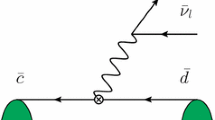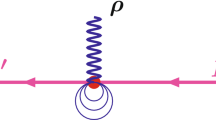Summary
We present a calculation ofS-wave ππ amplitudes based upon known rigorous results due to analyticity, unitarity and crossing symmetry; inequalities and crossing sum rules. The experimentalP-wave phase shifts between 500 and 1100 MeV are used as an input, and it is shown that the method leads to sharpS-wave phase-shift predictions for a given very-low-energyP-wave amplitude. Uncertainties in the extrapolation of the experimentalP-wave phase shifts downwards are mainly responsible for a reasonable dispersion ofS-wave phase shifts. Much care is taken in order to introduce correctly long-range forces into the game. The results, in very good agreement with experiment, are physically interpreted, and compared with those of other models, in particular current algebra and field theory calculations.S-wave scattering lengths and zeros are found to be in agreement with current algebra models. A well-defined σ-meson is predicted under the form of a second-sheet pole inI=0S-wave amplitude. Its mass,m σ=420 MeV, is remarkably independent of any variation of all parameters, in particular of theP-wave scattering length, and it exists even if the phase shift does not pass through 90°. This phase shift is found to be of the «down» type above the ρ mass in the absence of inelasticity. Our conclusion is that, if there are no strongI=2D-wave forces, the relationship betweenS andP waves is well determined by analyticity, crossing symmetry and unitarity.
Riassunto
Si presenta un calcolo delle ampiezze ππ in ondaS basato sui noti risultati rigorosi dovuti all’analiticità, l’unitarietà e la simmetria incrociata: ineguaglianza e regole di somma incrociate. Si usano come entrate gli spostamenti di fase dell’ondaP fre 600 e 1100 MeV, e si mostra che il metodo porta a nette predizioni degli sponstamenti di fase dell’ondaS per una data ampiezza di ondaP di bassissima energia. Le incertezze nella estrapolazione degli spostamenti di fase dell’ondaP in giù sono i principali responsabili di una ragionevole dispersione degli spostamenti di fase dell’ondaS. Si ha molta cura di mettere in giuoco correttamente le forze di lungo raggio. Si interpretano fisicamente i risultati, in buon accordo con i dati sperimentali, e li si confronta con quelli di altri modelli, in particolare i calcoli con l’algebra delle correnti e la teoria dei campi. Si trova che le lunghezze di scattering e gli zeri dell’ondaS sono in accordo con quelli dei modelli dell’algebra delle correnti. Si predice un ben definito mesone σ sotto la forma di un polo del secondo foglietto nell’ampiezza dell’ondaS, I=0. La sua massa,m σ=420 MeV, è notevolmente indipendente da ogni variazione dei parametri, in particolare dalla lunghezza di scattering dell’ondaP, ed esiste anche se lo spostamento di fase non passa per 90°. Si trova che questo spostamento di fase è del tipo «in giù» al di sopra della massa del ρ in assenza di anelasticità. Si conclude che, se non vi sono intense forze di ondaD, I=2, la relazione fra le ondeS eP è ben determinata dall’analiticità, la simmetria incrociata e l’unitarietà.
Реэюме
Мы вычисляем ππ ампщитуды дляS-волны, основываясь на иэвестных строгих реэультатах: неравенствах и перекрестных правилах сумм, которые обусловлены аналитичностью, унитарностью и перекрестной симметрией. Как исходное, испольэуются зкспериментальные фаэовые сдвиги дляP-волны в области от 500 до 1100 МзВ. Покаэывается, что зтот метод приводит к предскаэаниям острых фаэовых сдвигов дляS-волн для эаданной амплитудыP-волны при очень ниэких знергиях. Неопределенности при зкстраполяции зкспериментальных фаэовых сдвигов дляP-волны книэу, в основном, являются причиной соответствуюшей дисперсии фаэовых сдвигов дляS-волны. Чтобы ввести в рассмотрение длиннодействуюшие силы, требуется эначительно больщая осторожность. Полученные реэультаты, которые очень хорощо согласуются с зкспериментом, интерпретируются с фиэической точки эрения и сравниваются с реэультатами других моделей, в частности, с вычислениями алгебры токов и теории поля. Обнаружено, что длины и нули рассеянияS-волны согласуются с моделями алгебры токов. Предскаэывается отчетливо выраженный б-меэон в виде полюса на втором листе у амплитудыS-волны приI=0. Его масса,m σ=420 МзВ, не эависит от любого иэменения всех параметров, в частности, от длины рассеянияР-волны, и меэон сушествует даже, если фаэовый сдвиг не проходит череэ 90°. Получено, что зтот фаэовый сдвиг представляет некоторый тип выщеупомянутой ρ-массы в отсутствии неупругости. Наще утверждение состоит в том, что соотнощение междуS- иP-волнами точно определяется аналитичностью, перекрестной симметрией и унитарностью, даже в том случае, когда не сушествуют сильные силы дляD-волны сI=2.
Similar content being viewed by others
References
Proceedings of the Argonne Conference on ππand πKInteractions (Argonne, 1969). Earlier references can be found in this book.
Proceedings of the XV International Conference on High-Energy Physics (Kiev, 1970).
E. Malamud andP. E. Schlein:Proceedings of the Argonne Conference on ππand πKInteractions (Argonne, 1969), p. 107.
J. P. Baton, G. Laurens andJ. Reignier: preprint CEN-Saclay, submitted toPhys. Lett. B (September 1970).
S. Weinberg:Phys. Rev. Lett.,17, 616 (1966);J. Iliopoulos:Nuovo Cimento,52 A, 192 (1967);53 A, 552 (1968).
P. Castoldi:Nucl. Phys.,12 B, 567 (1969).
S. Y. Chu andB. R. Desai:Phys. Rev. Lett.,21, 54 (1968);D. Morgan andG. Shaw:Nucl. Phys.,10 B, 261 (1969); preprint NYO-1932(2)-164 (1970);B. F. Gore: University of Maryland preprint 71-012 (August, 1970).
G. F. Chew andS. C. Frautschi:Phys. Rev. Lett.,5, 580 (1960);Phys. Rev.,123, 1478 (1961);P. D. B. Collins andR. C. Johnson:Phys. Rev.,177, 2472 (1969);182, 1755 (1969);185, 2020 (1969);F. Arbab andJ. T. Donohue:Phys. Rev. D,1, 217 (1970).
D. Bessis andM. Pusterla:Nuovo Cimento,54 A, 243 (1968);J. L. Basdevant, D. Bessis andJ. Zinn-Justin:Nuovo Cimento,60 A, 185 (1969).
J. L. Basdevant andB. W. Lee:Phys. Lett.,29 B, 437 (1969);Pion-pion dynamics in the σ model, Saclay preprint DPh-T/70/11JLB/BWL (April 1970), to be published inPhys. Rev.
J. L. Basdevant andJ. Zinn-Justin:Yang-Mills fields and the ππ interaction, Saclay preprint DPh-T/70-56.
C. Lovelace:Phys. Lett.,28 B, 264 (1968); see also the report byC. Lovelace in ref. (1a);R. Baier, H. Kühnelt andF. Widder: Universität Graz preprint (March 1970);H. M. Lipinski: Wisconsin University preprint COO-264 (June 1970). See alsoE. P. Tryon: Columbia University preprints NYO-1932(2)-153 and 177.
G. Wanders andO. Piguet:Nuovo Cimento,56 A, 417 (1968).
G. Auberson, O. Piguet andG. Wanders:Phys. Lett.,28 B, 41 (1968);B. Bonnier:Nucl. Phys.,10 B, 467 (1969);17 B, 525 (1970).
M. G. Olsson: Wisconsin preprint COO-282 (May, 1970);b)J. B. Carrotte andR. C. Johnson: University of Durham preprint, to be published inPhys. Rev.
B. Bonnier andP. Gauron:Nucl. Phys.,21 B, 465 (1970).
For a complete review and list of references, see:A. Martin:Scattering theory: unitarity, analyticity and crossing (Berlin, Heidelberg, New York, 1969).
J. L. Basdevant andJ. Reignier:Pion-pion interactions, inLecture Notes Herceg Novi School (1970).
A. P. Blachandran andJ. Nuyts:Phys. Rev.,172, 1821 (1968).
R. Roskies:Phys. Lett.,30 B, 42 (1969).
J. L. Basdevant, G. Cohen-Tannoudji andA. Morel:Nuovo Cimento,64 A, 585 (1969).
R. Roskies:Nuovo Cimento,65 A, 467 (1970).
A. Martin:Nuovo Cimento,47 A, 265 (1967);58 A, 303 (1968).
A. K. Common:Nuovo Cimento,53 A, 946 (1968).
A. Martin:Nuovo Cimento,63 A, 167 (1969).
G. Auberson, O. Brander, G. Mahoux andA. Martin:Nuovo Cimento,65 A, 743 (1970).
G. Auberson:Nuovo Cimento,68 A, 281 (1970).
Another type of inequality has also been obtained under the form of integral inequalities. See, for example
O. Piguet andG. Wanders:Phys. Lett.,30 B, 418 (1969)
G. Wanders:Nuovo Cimento,63 A, 108 (1969);R. Roskies:Phys. Rev. D,2, 247 (1970)
A. P. Balachandran andM. L. Blackmon:Phys. Lett.,31 B, 655 (1970) They have not been considered here because in some sense they are another form of the inequalities of ref. (22–26), and of dispersion relations, though not strictly equivalent. Actually, we have checked that our solutions satisfy the integral inequalities given to us byO. Piguet (private communication).
M. G. Olsson:Phys. Rev.,162, 1338 (1967).
We think that here is one of the reasons why, though using the same kind of procedure (but not the same construction ofS andP waves) asBonnier andGauron in ref. (14), we do not find the same results: in fact, it can be seen with the numbers they give for the Roskies equations (written with nonorthogonal polynomials) that in particular theE 5 equation is not well satisfied.
D. Lévy: private communication.
D. H. Lyth: CERN preprint TH. 1143 (March, 1970).
S. L. Adler:Phys. Rev.,137, B 1022 (1965).
J. Zinn-Justin: private communication.
D. Atkinson:Nucl. Phys.,7 B, 375 (1968);8 B, 377 (1968).
Author information
Authors and Affiliations
Additional information
Part of this work was done while this author was a NATO Fellow on leave from Laboratoire de Physique Atomique et Moléculaire, Collège de France, Paris.
Rights and permissions
About this article
Cite this article
Le Guillou, J.C., Morel, A. & Navelet, H. Unambiguous ππS-Waves from general principles and the existence of the ρ-meson. Nuov Cim A 5, 659–700 (1971). https://doi.org/10.1007/BF02734572
Received:
Published:
Issue Date:
DOI: https://doi.org/10.1007/BF02734572




